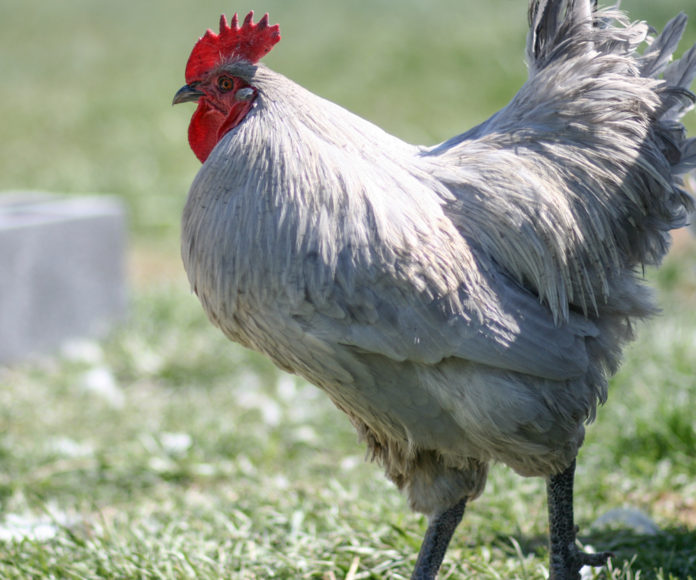Last Updated on January 25, 2024 by Fumipets
Lavender Orpington Chicken: A Gentle Breed with a Splash of Elegance
The Lavender Orpington chicken, with its striking lavender-hued plumage, stands out as a captivating and gentle breed within the poultry world. Known for more than just its ornate appearance, this breed has gained popularity for its friendly demeanor, making it a favorite among chicken enthusiasts and backyard flock keepers alike.
Let’s delve into the charm of the Lavender Orpington through a series of questions and answers.
Lavender Orpington Chicken
Due to their hardiness and gentle nature, Orpington chickens are one of the most popular breeds among backyard breeders. These birds now come in a range of colors after years of breeding. Have you ever seen or heard of a Lavender Orpington? You’ve probably heard of the very popular Buff Orpington. These somewhat more uncommon birds have a distinctive look and a subdued lavender colour, but they nevertheless exhibit all the characteristics that have made Orpingtons such a well-liked breed.
Quick Facts about Lavender Orpington
| Species Name: | Gallus gallus domesticus |
| Family: | Orpington |
| Care Level: | Minimal |
| Temperature: | 0-100 degrees Fahrenheit |
| Temperament: | Docile |
| Color Form: | Lavender |
| Lifespan: | 8+ years |
| Size: | 7-10 pounds |
| Diet: | Omnivore |
| Minimum Habitat Size: | 2-3 square feet per bird |
| Habitat: | Chicken coup |
Lavender Orpington Chicken Overview
One of the less common Orpington variants is the lavender variety. They make wonderful home poultry farmers since they produce enough eggs and have a big physique that’s perfect for gathering meat. Orpingtons are exceptionally sturdy and weather-resistant, which is also vital for the backyard chicken farmer.
This breed was initially developed in a little English town named Orpington. In the early 1800s, exotic birds and breeds were crossed to produce distinctive and eye-catching chickens in England, where they were quite popular. However, when society shifted toward a more utilitarian mindset in the late 1800s, birds that laid a lot of eggs and produced a lot of meat were much more prized.
The first black Orpington was made at this period by William Cook. This bird was unique due to its size and respectable egg-laying prowess. Most English chickens at the time were little and didn’t provide much food.
Orpingtons have gained popularity once again in recent years. Although they had previously been well known, they had long since fallen into danger. A new type called Lavender Orpingtons has only just developed. They look to be highly unusual because of their distinctive purple coloring, which is easily noticeable.

How Much Do Lavender Orpingtons Cost?
Lavender Orpingtons are not exceptionally costly birds despite their extreme rarity. Male chicks often cost less than $5. Hens may be more expensive than Orpingtons of any other kind, costing $8 to $15 on average per chick. Typically, if you buy many, you may get them even cheaper since chickens sometimes come with bulk discounts.
Typical Behavior & Temperament
It is well known that Lavender Orpingtons are affectionate hens. They like being in huge flocks and are often quite amicable with people. Even more so if there is just one, roosters may be very territorial. It is possible to socialize aggressive Lavender Orpingtons to help them become more docile.
Appearance & Varieties
Despite being one of the most striking colors, the Orpington chicken’s lavender variety is not one of the breed’s registered colors. Even yet, it continues to gain popularity since consumers tend to prefer hens that not only produce eggs and meat in large quantities, but also have stunning and distinctive looks.
Lavender Orpingtons are, as its name implies, pale lavender in hue. Although some specimens may have a more distinctly lavender color, the majority of them are really gray with a subtle lavender tinge. They have wide, smooth feathers, slate- or blue-colored feet, and shanks. A single, five-pointed comb is used by lavender orpingtons.
When fully grown, roosters typically weigh 9 to 10 pounds. Hens typically weigh eight pounds, which is a little less.

How to Take Care of Lavender Orpington
Habitat, Conditions & Setup
The ease of keeping Orpington chickens is one of the key factors contributing to their appeal. They can readily withstand cold winters and sweltering summers since they are very adaptable to a broad variety of weather conditions.
You may house them in a typical chicken coop that provides each bird with at least two to three square feet of area. Make sure you’re providing a place to escape the elements. In order to provide the birds with some relief during days of bad weather, this area must be dry and wind-free.
Your birds will need access to a bigger area where they may wander and graze in addition to the space within the coup. You’ll need roughly 10 square feet per bird for this bigger chicken run. Many people use mobile chicken trailers, which enable you to move the chicken coop and run to a different location each day with plenty of foraging food.
Lavender Orpingtons may thrive when let to forage freely. They are resilient chickens with few needs. Your Lavender Orpingtons should thrive if you only provide them a place to live, food to eat, and shelter from the weather.
Do Lavender Orpingtons Get Along with Other Pets?
In general, lavender orpingtons are regarded as sociable chickens. As a result, they get along with any creatures that are often known to live with chickens. These birds often get along well with people and are even given pet-like status, sitting on their owners’ laps.
Horses, cows, sheep, donkeys, goats, and even llamas are some creatures that a Lavender Orpington could befriend. Of course, your birds’ particular temperaments will ultimately determine how this plays out. Not all Lavender Orpingtons will get along well with other animals, despite the possibility.
What to Feed Your Lavender Orpington
Grass and weeds will be your Lavender Orpington’s preferred foods. They will hunt for these plants, eating their seeds in the process. They will gladly consume a variety of different foods when foraging, including slugs, earthworms, and other insects.
The majority of hens in small farms and backyards are also fed leftovers from households. Chickens may consume a variety of things, but unless you want your chicken’s eggs to taste peculiar, avoid giving them beans, garlic, onions, or citrus. Additionally, avoid giving your Lavender Orpingtons any raw potatoes since they are harmful to hens.

Keeping Your Lavender Orpington Healthy
It’s not too difficult to keep hens healthy. You won’t need to do much to maintain chickens in excellent form since they are inherently robust and healthy creatures. When given the right care, they seldom get ill. The majority of backyard poultry growers go years without losing any birds to disease.
Chickens are resilient, yet they are prone to certain illnesses. One sick bird might quickly spread the disease across the flock. You should make sure your hens live in a clean environment to avoid this. Additionally, they need easy access to lots of good food and clean water.
Lavender Orpingtons need enough room to be healthy. Keep your flock of hens from being crowded into a confined area. Don’t let the area become wet around them. In a chicken coop, moisture may increase the bacterial population. And of course, keep predators away from them. Everything from foxes and coyotes to bobcats and wolves like chicken as a good meal.
Breeding
Without a rooster around, hens will still lay eggs. Of course, no chicks will hatch from these eggs. Although they provide excellent food, you need a hen and a rooster to fertilize the eggs if you want to breed your chickens.
In chilly areas in particular, hens lay more fertile eggs in the spring than at any other time of the year. It is thus the ideal moment to try breeding.
Choose a rooster and leave it with your hens for breeding. You just need to do that. The hard job of wooing, dancing for, and seducing the girls will be done for you by your rooster. Your rooster will eventually start mating with the hens, giving you a large number of fertilized eggs.
Are Lavender Orpingtons Suitable for You?
Lavender Orpingtons are a terrific option for your flock if you raise poultry in your garden. Lavender Orpingtons may work for you whether you want birds mainly for egg production or you want to grow some for meat. They are excellent dual-purpose chickens since they produce around 200 eggs a year and grow to be 8 to 10 pounds as adults.
Fortunately, Lavender Orpingtons don’t cost a lot of money. They can endure both cold and icy winters and scorching summers with ease. They are a fantastic option for any chicken keeper since they are amiable and aren’t known to be aggressive. The unusual lavender coloring is really an added bonus.
Questions and Answers on Lavender Orpington Chicken:
What Defines the Lavender Orpington’s Appearance?
The Lavender Orpington boasts a unique lavender-gray feathering that sets it apart from other chicken breeds. The plumage is soft, fluffy, and exudes a regal elegance, making these chickens a delightful addition to any flock.
What is the Origin of Lavender Orpington Chickens?
The Lavender Orpington is a variety of the Orpington breed, originating in England in the late 1800s. Orpington chickens were initially bred for meat and egg production, and the Lavender variety emerged as a distinct color mutation appreciated for its aesthetic appeal.
What Temperament Can be Expected from Lavender Orpingtons?
Known for their calm and docile nature, Lavender Orpingtons make excellent pets. These chickens are known to be friendly, gentle, and easily approachable, making them a favorite among families, especially those with children.
How Well Do Lavender Orpingtons Adapt to Backyard Settings?
Lavender Orpingtons are well-suited for backyard environments. They adapt well to both confined spaces and free-range settings, demonstrating a peaceful disposition. Their feathered feet and gentle temperament contribute to their suitability for various living conditions.
What are the Egg-Laying Characteristics of Lavender Orpington Hens?
While Lavender Orpingtons are not the most prolific layers, they contribute a respectable number of large brown eggs. Their consistent egg production, combined with their friendly nature, makes them a popular choice for backyard flocks where a balance of companionship and egg yield is desired.


















